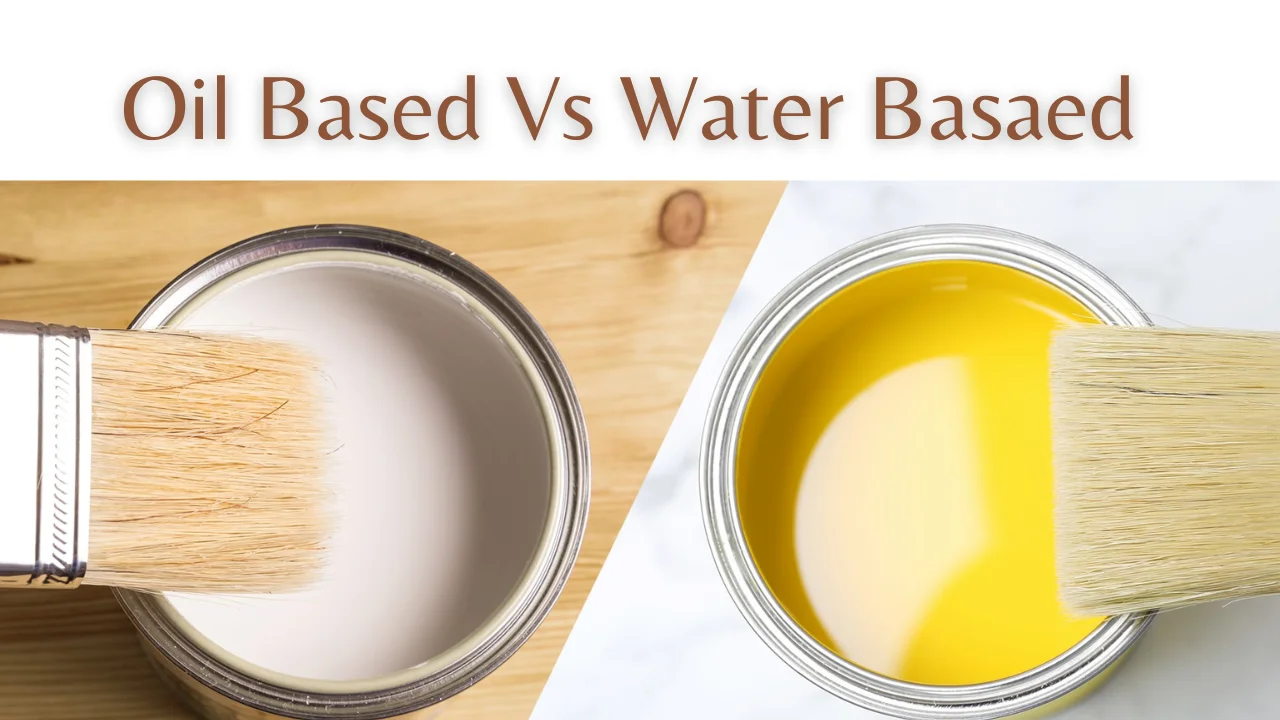Oil based vs water based refers to the type of liquid solvent used in paints and other products. Oil-based uses Oil as the base, while water-based uses water. Regarding painting projects, oil-based and water-based paints are more than just a brush stroke.
Understanding the fundamental differences between these two paint types can be the key to a successful project. Starting from Oil based vs water based, let’s embark on a journey that simplifies this complex topic.
We’ll break down the advantages, disadvantages, and ideal applications for each, ensuring you have all the knowledge you need to make the right choice for your next painting adventure.
Oil Based vs Water Based
When we talk about Oil based vs water based paint, we talk about the stuff that evaporates as the paint dries – the solvent.

Source Pinterest
Oil-based paints, often confused with enamel paints, use mineral turpentine as their solvent. On the other hand, water-based paint, also called acrylic paint, is mainly water. It’s as simple as oil-based relies on a turpentine base, while water-based is mostly water.
The Pros and Cons of Oil Based vs Water Based
Pros and Cons of Oil-Based Paints

Source Pinterest
Durability
Oil-based paints are known for their exceptional durability. They form a hard, resilient surface that withstands harsh environmental conditions, including moisture, temperature fluctuations, and wear and tear. It makes them an excellent choice for high-traffic areas like kitchens and bathrooms.
Smooth Finish
Oil-based paints provide a flawless, smooth finish, making them the top choice for enhancing the aesthetic appeal of woodwork, trim, and doors.
Their ability to conceal surface imperfections ensures a polished, professional look, ideal for areas where appearance matters most. The smooth texture achieved with oil-based paints enhances the visual appeal and contributes to their popularity for interior and exterior applications, demanding a refined, blemish-free surface.
Versatility
Oil-based paints stand out for their versatility and are suitable for various surfaces. They prove their adaptability in countless applications, from wood and metal to concrete and masonry.
The ability to work effectively across these surfaces makes oil-based paints a dependable choice for homeowners and professionals alike, offering a single solution for multiple painting needs and ensuring a consistent, quality finish on diverse materials.
Cons

Source Pinterest
Strong Odor
One of the most significant drawbacks of oil-based paints is their strong and often unpleasant odor during application and drying. It can be bothersome and may require proper ventilation to mitigate the smell. It also makes them less suitable for indoor projects in occupied spaces.
Environmental Concerns
Oil-based paints contain volatile organic compounds (VOCs), which can contribute to air pollution and have adverse health effects.
Due to these environmental concerns, many regions have imposed strict regulations on oil-based paints. Water-based paints are generally considered more environmentally friendly as they have lower VOC content.
Pros and Cons of Water-Based Paint

Source Pinterest
Quick Drying Time
One of the standout advantages of water-based paints is their swift drying process, usually taking just a few hours. This rapid drying time significantly expedites painting projects, minimizing the inconvenience and downtime from waiting for paint to dry. It proves especially advantageous for tasks necessitating multiple coats or touch-ups.
With water-based paints, you can efficiently apply subsequent layers or address any imperfections without protracted delays, streamlining the entire painting process and allowing spaces to be quickly restored to their intended use.
Easy Cleanup
Cleanup with water-based paints is a breeze. You can wash brushes, rollers, and other painting tools with water and soap, eliminating the need for harsh solvents or thinners. It not only simplifies the painting process but also reduces the environmental impact by minimizing the use of chemical cleaners.
Flexibility and Adhesion
Water-based paints adhere well to various surfaces, including drywall, plaster, wood, and masonry. They are flexible and can expand and contract with temperature fluctuations and structural movements without cracking or peeling. It makes them a versatile choice for both interior and exterior applications.
Cons

Source Pinterest
Less Durability
While water-based paints are durable but generally less resilient than oil-based paints, especially in high-traffic or harsh-weather areas, they may require more frequent touch-ups or repainting in such situations.
Limited Application on Certain Surfaces
Water-based paints may not be suitable for all surfaces. They can only adhere to glossy or oil-based painted surfaces with proper preparation, such as sanding or priming. In such cases, the adhesion may be compromised, leading to peeling or flaking over time.

